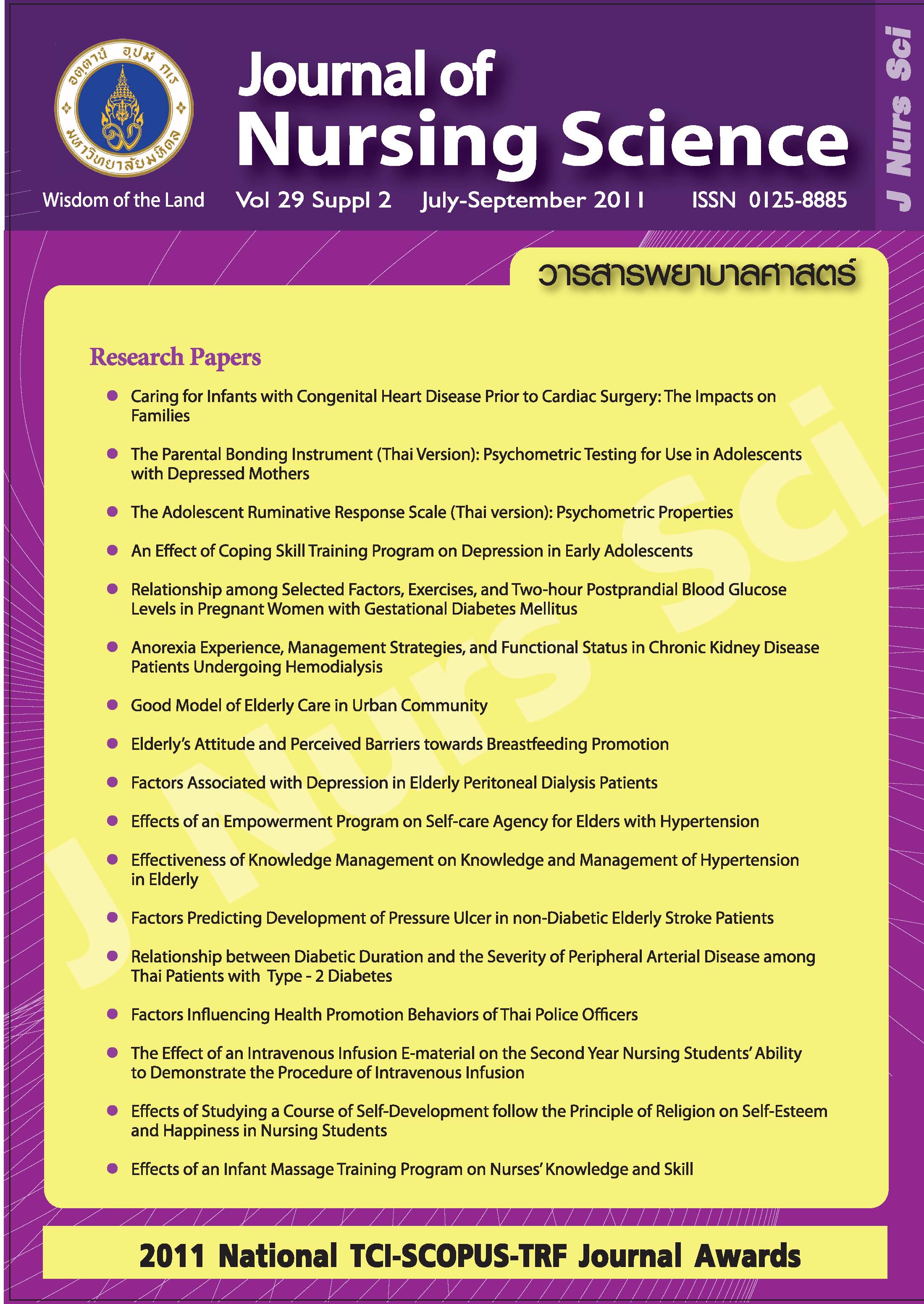The Effect of an Intravenous Infusion E-material on the Second Year Nursing Students’ Ability to Demonstrate the Procedure of Intravenous Infusion
Main Article Content
Abstract
Purposes: To compare the nursing students’ ability todemonstrate the procedure of intravenous infusion between anexperimental group learning through intravenous infusione-material and a control group learning through usual methods ofdemonstration and return-demonstration, and to assess thesatisfaction of using the intravenous infusion e-material.
Design: Quasi-experimental research design.
Methods: The sample was the bachelor degree second yearnursing students at the Faculty of Nursing, Mahidol Universitywith a total number of 135. All participants were simple randomlyassigned to the control group (n = 71) and the experimental group(n = 64). Data were collected by using a procedure checklist and asatisfaction questionnaire. Descriptive statistics (mean, standarddeviation) and t-test were used for data analysis.
Main findings: Significantly, the experimental group showedhigher competency (p < .01) in demonstrating the procedure ofintravenous infusion than did the control group. The participantsin the experimental group were also satisfied with usingintravenous infusion e-material at a high level.
Conclusion and recommendations: Using the intravenousinfusion e-material is very useful for the nursing students. Thestudents are able to study at their own convenience and as often asneeded till their ability being developed. The e-material, therefore,is a very significant tool in improving quality of education.
Article Details
Copyright Notice: Nursing Science Journal of Thailand has exclusive rights to publish and distribute the manuscript and all contents therein. Without the journal’s permission, the dissemination of the manuscript in another journal or online, and the reproduction of the manuscript for non-educational purpose are prohibited.

Disclaimer: The opinion expressed and figures provided in this journal, NSJT, are the sole responsibility of the authors. The editorial board bears no responsibility in this regard.
References
Weinstien SM. Plummer’s Principles & Practice of Intravenous Therapy. 7th ed. Philadelphia: Lippincott; 2000.
Beeson SA, Kring DL. The effects of two J Nurs Sci Vol 29 Suppl 2 July-September 2011 Journal 150 of Nursing Science teaching methods on nursing students’ factual knowledge and performance of psychomotor skills. J Nurs Educ. 1999;38(8):357–9.
Jeffries PR. Computer versus lecture: A comparison of two methods of teaching oral medication administration in a nursing skills laboratory. J Nurs Educ. 2001;40(7):323–9.
Jeffries PR, Woolf S, Linde B. Technologybased vs. traditional instruction-a comparison of two methods for teaching the skill of performing a 12-lead ECG. Nurs
Educ Perspect. 2003;24(2):70–4.
Su-Chen C, Kuei-Yueh C, Tzu-Kuan S, Ku-Chou C, Teng-Yeow T, Tsu-Kung L, et al. The effectiveness of interactive computer assisted instruction compared to videotaped instruction for teaching nurses to assess
neurological function of stroke patients: A randomized controlled trial. Int J Nurs Stud. 2009;46:1548-56.
Jelovsek FR, Adebonojo L. Learning principles as applied to computer-assisted instruction. M.D. Computing. 1993;10(3):165-72.
Rouse DP. Computer-assisted instruction: An effective instructional method. Teach Learn Nurs. 2007;2:138-43.
Erdfelder E, Faul F, & Buchner A. G POWER: A general power analysis program. Behav Res Meth Ins C. 1996;28:1-11.
Kannasuite P. Statistic for Behavioral Research. Bangkok: Chulalongkorn University Press; 2538. (in Thai).
Kanjanawasee S. Modern test theories. Bangkok: Chulalongkorn University Press; 2545. (in Thai).
Harrington SS, Walker BL. Is computerbased instruction an effective way to present fire safety training to long-term care staff? J Nurs Staff Dev. 2003;19(3):147-54.
Reis J, Trockel M, King T, Remmert D. Computerized training in breast selfexamination: A test in community health center. Cancer Nurs. 2004;27(2):162-8.
Sanglee K, Srisawang J, Chaiwuth S, Baosoung C. Development of computer - assisted instruction program entitled: Conduct of normal delivery for nursing students. J Nurs. 2010;37(1):5-25. (in Thai).
Chuto P, Parisulyakul S, Putjorn P. Effects of computer assisted instruction on mechanism of labor on knowledge of nursing students. Thai J Nurs Educ. 2007;1(1):23-32. (in Thai).
Boonchan N, Sujijantararat R, Effects of computer assisted- instruction lesson: Intermittent catheterization for nursing students, Faculty of Nursing, Mahidol University. Thai J Nurs. 2005;54(1):42-53. (in Thai)

